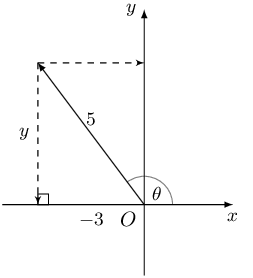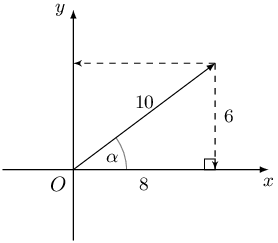Draw a sketch:

|
Previous
4.2 Compound angle identities
|
Next
4.4 Solving equations
|
We have shown that \(\sin\left(\alpha +\beta \right)=\sin\alpha\cos \beta +\cos\alpha\sin \beta\). If we let \(\alpha =\beta\), then we can write the formula as:
\begin{align*} \sin \left(2\alpha \right) &= \sin\left(\alpha +\alpha \right) \\ & = \sin \alpha\cos \alpha +\cos\alpha\sin \alpha \\ \therefore \sin 2\alpha & = 2\sin\alpha\cos \alpha \end{align*}Similarly, we know that \(\cos\left(\alpha +\beta \right)=\cos\alpha\cos \beta -\sin\alpha\sin \beta\). If we let \(\alpha =\beta\), then we have:
\begin{align*} \cos \left(2\alpha \right) &=\cos\left(\alpha +\alpha \right) \\ & = \cos \alpha\cos \alpha -\sin\alpha\sin \alpha \\ \therefore \cos 2\alpha & = \cos^{2}\alpha -\sin^{2}\alpha \end{align*}Using the square identity, \(\sin^{2} \alpha + \cos^{2}\alpha = 1\), we can also derive the following formulae:
\begin{align*} \cos 2\alpha & = \cos^{2}\alpha -\sin^{2}\alpha \\ & = \left( 1 - \sin^{2}\alpha \right) - \sin^{2}\alpha \\ \therefore \cos 2\alpha & = 1 - 2 \sin^{2}\alpha \end{align*}And
\begin{align*} \cos 2\alpha & = \cos^{2}\alpha -\sin^{2}\alpha \\ & = \cos^{2}\alpha - \left( 1 - \cos^{2}\alpha \right) \\ & = \cos^{2}\alpha - 1 + \cos^{2}\alpha \\ \therefore \cos 2\alpha & = 2 \cos^{2}\alpha - 1 \end{align*}Double angle formulae
If \(\alpha\) is an acute angle and \(\sin \alpha = \text{0,6}\), determine the value of \(\sin 2 \alpha\) without using a calculator.
We convert \(\text{0,6}\) to a fraction so that we can use the ratio to represent the sides of a triangle.
\begin{align*} \sin \alpha &= \text{0,6} \\ &= \frac{6}{10} \end{align*}
Check the answer using a calculator:
\begin{align*} \sin \alpha &= \text{0,6} \\ \therefore \alpha &\approx \text{36,87} ° \\ 2 \alpha &\approx \text{73,74} ° \\ \therefore \sin \left( \text{73,74} ° \right) &\approx \text{0,96} \end{align*}Prove that \(\frac{\sin\theta +\sin2\theta }{1 + \cos\theta +\cos2\theta } = \tan\theta\).
For which values of \(\theta\) is the identity not valid?
The right-hand side (RHS) of the identity cannot be simplified, so we simplify the left-hand side (LHS). We also notice that the trigonometric function on the RHS does not have a \(2\theta\) dependence, therefore we will need to use the double angle formulae to simplify \(\sin2\theta\) and \(\cos2\theta\) on the LHS.
We know that \(\tan \theta\) is undefined for \(\theta = \text{90} ° + k \cdot \text{180} °, k \in \mathbb{Z}\).
Note that division by zero on the LHS is not allowed, so the identity will also be undefined for:
\begin{align*} 1 + \cos\theta +\cos2\theta & = 0 \\ \cos\theta \left( 1 + 2\cos\theta \right) & = 0 \\ \therefore \cos \theta = 0 &\text{ or } 1 + 2\cos\theta = 0 \\ & \\ \text{For } \cos \theta = 0, \quad \theta &= \text{90} ° + k \cdot \text{180} ° \\ & \\ \text{For } 1 + 2 \cos \theta = 0, \quad \cos \theta &= - \frac{1}{2} \\ \therefore \theta &= \text{120} ° + k \cdot \text{360} ° \\ \text{or } \theta &= \text{240} ° + k \cdot \text{360} ° \end{align*}for \(k \in \mathbb{Z}\).
Given \(5 \cos \theta = -3\) and \(\theta < \text{180} °\). Determine the value of the following, without a calculator:
Draw a sketch:

Given \(\cos \text{40} ° = t\), determine (without a calculator):
Restrictions:
\begin{align*} \sin 2 A &\ne 0 \\ \therefore 2A &\ne \text{0} ° + k \cdot \text{180} ° \\ \therefore A &\ne \text{0} ° + k \cdot \text{90} °, \quad k \in \mathbb{Z} \\ \text{And } \tan 2 A &\ne 0 \\ \therefore 2A &\ne \text{90} ° + k \cdot \text{180} ° \\ \therefore A &\ne \text{45} ° + k \cdot \text{90} °, \quad k \in \mathbb{Z} \\ \text{And for } \tan A &: \\ A &\ne \text{90} ° + k \cdot \text{180} °, \quad k \in \mathbb{Z} \end{align*}Without using a calculator, find the value of the following:
Check the answer using a calculator.
Check the answer using a calculator.
Restrictions:
\begin{align*} \cos 2 x &\ne 0 \\ \therefore 2x &\ne \text{90} ° + k \cdot \text{180} ° \\ \therefore x &\ne \text{45} ° + k \cdot \text{90} °, \quad k \in \mathbb{Z} \\ \text{And } \cos x &\ne \sin x \\ \therefore x &\ne \text{45} ° + k \cdot \text{180} °, \quad k \in \mathbb{Z} \\ \text{And for } & \tan 2 x \\ \therefore 2x &\ne \text{90} ° + k \cdot \text{180} ° \\ \therefore x &\ne \text{45} ° + k \cdot \text{90} °, \quad k \in \mathbb{Z} \end{align*}Consider the denominator on the LHS:
\begin{align*} \cos 2x &= \cos 2 \left( \text{45} ° \right) \\ &= \cos \text{90} ° \\ &= 0 \end{align*}Consider the denominator on the RHS:
\begin{align*} \cos \text{45} ° &= \sin \text{45} ° \\ \therefore \cos \text{45} ° - \sin \text{45} ° &= 0 \end{align*}Therefore, the identity will be undefined because division by zero is not permitted.
|
Previous
4.2 Compound angle identities
|
Table of Contents |
Next
4.4 Solving equations
|